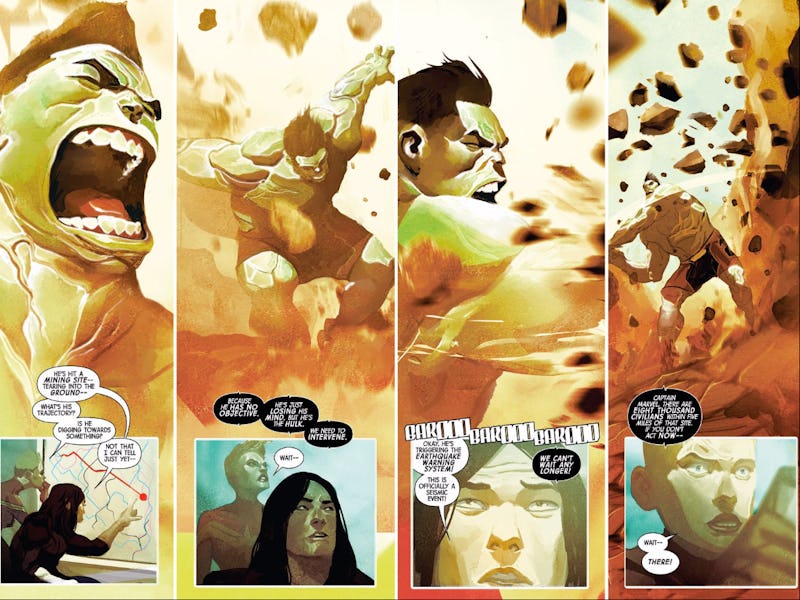This Year, We Allowed Our Male Superheroes to Feel Weak
Hulk, Batman, and the Green Ranger pushed a new paradigm in masculinity: Be vulnerable.

The last few years have been especially exciting for mainstream superhero comics. The Big Two publishers (Marvel and DC) and smaller independent publishers (Valiant, BOOM!, Dark Horse) have made strides in populating their universes with characters who more accurately reflect the values of their diverse readerships.
Other popular superheroes — most of them characterized by hyper-masculine frames and emotional responses — spent 2016 in a rut. DC’s Batman, Marvel’s Totally Awesome Hulk, and BOOM! Studios’ Mighty Morphin Power Rangers, and even The Unworthy Thor explored a vulnerability rarely exhibited by square-jawed titans. 2016’s huge shift in superhero comics was allowing them to doubt themselves.
Current mainstream titles like Batman and Power Rangers are exemplary in their depiction of masculine anxiety. Batman writer Tom King, tells Inverse that Batman admitting to Catwoman that he cut himself as a teenager is consistent with the character’s long history. “When you’re in that kind of depression, the first thought is ‘I’m the only one who’s ever experienced this’ and if that’s your last thought, you drown under it,” King says.
“I was ten,” Batman writes to Catwoman in Batman #12. “I got one of my father’s razor blades, and I got down on my knees. I put the metal against my wrist. The edge scratching cold. The blood on my hand.” He continues. “I told them I was sorry, so sorry.”
Batman #12 is a rare exploration of when Batman’s internal strife, when he wasn’t yet a hardened, vengeful gargoyle, but simply a young man trying to make sense of things. Many who have written Batman — in comics, TV, and movies — have generally agreed that Bruce nurses a great deal of guilt over the death of his parents; in Christopher Nolan’s 2005 epic Batman Begins, Henry Ducard (Liam Neeson) asks Christian Bale’s Bruce Wayne why he still considers his parents’ death his fault. “My anger outweighs my guilt,” Bruce answers, but as the film progresses, audiences are left to ponder if that’s really true.
This year, in Detective Comics from James Tynion IV, Batman lost Tim Drake (who actually survived, but he doesn’t know that) and as a result tried to overcompensate for his limitations during the arc “Night of the Monster Men.” In Batman v Superman, Batman tries to make up for his own sins by saving Superman’s mother.
From 'Batman' #7, the first part of "Night of the Monster Men" after Timothy Drake's "death."
Meanwhile, in the Marvel Universe, Greg Pak’s Totally Awesome Hulk addressed the death of Bruce Banner by allowing Amadeus Cho — the “Totally Awesome” Hulk — to troll Captain Marvel and fight Black Panther. He is motivated solely by the sense of loss.
Since taking over as the new Hulk, Amadeus has endured growing pains in accepting the responsibility of being a living WMD. Much as Amadeus believed he had his Hulk in check, he still relied on his hero Bruce Banner for advice and guidance and spent all of issue #8 by his side. Things went belly up in the events of Civil War II, when Hawkeye killed him in a preemptive strike to prevent a devastating future seen by the Inhuman, Ulysses. After Danvers pays a visit to the Cho family in issue #9, to make amends as well as show she’s not to be messed with, Amadeus does exactly that by trolling the hell out of her with a rampage and smashing “MADE YOU LOOK” into the ground.
Carol Danvers is one the legit strongest superheroes in the Marvel Universe, but Amadeus Cho was emotionally devastated enough to mock her.
Even if Amadeus had virtually nothing to do with Banner’s death, of course Amadeus feels guilty; he cured Banner of his Hulk, which would have saved him from Hawkeye’s arrow.
In the world of Mighty Morphin Power Rangers, the reboot comic of the 1993 TV show set in 2016, a reformed Tommy the Green Ranger suffers from PTSD. Before the events of these comics, he was Rita’s control, acting out atrocities in her name. He finds himself paralyzed, unable to move past his guilt, something the TV show erroneously glossed over. Throughout the first few issues, Tommy hallucinates his former empress Rita Repulsa whispering doubt into his ear.
The Power Rangers rarely show inner turmoil or anxiety — even if they are “overbearing, over-emotional” teenagers — but Kyle Higgins has actually achieved nuance in his acclaimed run with BOOM! Studios. Unlike most superheroes, the Power Rangers are meant to work as a unit, more effective together than apart. But Rita’s seeds of doubt have threatened this collaborative system, leaving Earth vulnerable to attack.
Across publishers, many comic creators seem keen on this new narrative: Their male characters can exhibit emotions and break down. They can doubt their worth and appear weak to other characters, and to the reader.
Despite, or perhaps because of, these changes, Batman enjoyed a regular spot in the top five monthly comic sales, while Totally Awesome Hulk and Mighty Morphin Power Rangers are always in flux. (November was sort of punishing for the latter; Hulk was #120 while Power Rangers was #127 in sales.) But with the Hulk part of Marvel’s Champions (its first issue was the second best-selling title in October) and the new White Ranger driving an intriguing plot mystery, all three books are primed to assure their audiences that vulnerability, sometimes, means strength.